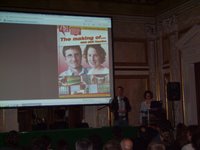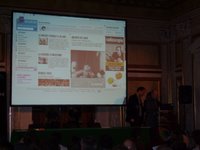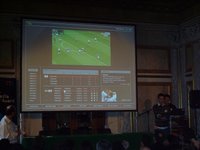It is not surprising that the Swiss broadcast archival application won. The broadcast companies all around Europe are busy to digitise and archive their historical material, not just for preservation, but also for use in education and entertainment. In fact on December 1, 2006 a new institute for image and sound will be opened in The Netherlands (I will report on this on that day).
 Swiss Timeline (Switserland) provides an overview of Swiss history since 1931 as reflected by public service radio and television. Searchable according to subject, period, type of media and language, users can warp themselves back in time and follow Swiss life as it was originally reported. Site visitors can follow the cycle of events and their context by using the dynamic timeline interface, or simply select a wide range of thematically organised reports, interviews and debates. By using the powerful search engine or following the editor’s selections, users can follow the historical cycles of events (e.g. natural disasters) or national issues (e.g. debates about nuclear power, immigration or WWII). Developed in cooperation with the Swiss Broadcasting Corporation and designed using an attractive hybrid Flash/HTML composition, Swiss Timeline aims to raise awareness about Switzerland both at home and abroad.
Swiss Timeline (Switserland) provides an overview of Swiss history since 1931 as reflected by public service radio and television. Searchable according to subject, period, type of media and language, users can warp themselves back in time and follow Swiss life as it was originally reported. Site visitors can follow the cycle of events and their context by using the dynamic timeline interface, or simply select a wide range of thematically organised reports, interviews and debates. By using the powerful search engine or following the editor’s selections, users can follow the historical cycles of events (e.g. natural disasters) or national issues (e.g. debates about nuclear power, immigration or WWII). Developed in cooperation with the Swiss Broadcasting Corporation and designed using an attractive hybrid Flash/HTML composition, Swiss Timeline aims to raise awareness about Switzerland both at home and abroad.Team: Dominik Stankowski, Cecile Cosman, Dani Wihler, Laurent Andrey, Denise Hegnauer, Andrea Stephani, Marco Majoleth, Kai Reusser, Lukas Jaggi.
 Archives For All (France) clearly organises almost 100,000 radio and TV recordings and 10,000 hours of material into four capsules: explore, discover, share and download. The “Explorer” module enables users to search for particular topics, personalities and programmes or focus on any year or decade. The “Decouvrir” module surprises users with random selections from ten archives, carefully chosen educational programmes, an interactive timeline about the history of French media and even the daily news since 1963. The “Partager” module offers thematically organised forums and the editors’ daily selections. Users can subscribe to the service or download any content in the “Telecharger” module. Selections can be fully customised and even shared in the “mon espace personnel” section. The “ma zone mémoire” toolbar compresses any recently viewed clips, enabling the user to retain control.
Archives For All (France) clearly organises almost 100,000 radio and TV recordings and 10,000 hours of material into four capsules: explore, discover, share and download. The “Explorer” module enables users to search for particular topics, personalities and programmes or focus on any year or decade. The “Decouvrir” module surprises users with random selections from ten archives, carefully chosen educational programmes, an interactive timeline about the history of French media and even the daily news since 1963. The “Partager” module offers thematically organised forums and the editors’ daily selections. Users can subscribe to the service or download any content in the “Telecharger” module. Selections can be fully customised and even shared in the “mon espace personnel” section. The “ma zone mémoire” toolbar compresses any recently viewed clips, enabling the user to retain control.Team: Safia Dziri, Paul Fleury, Jean Miguel Kawamura, Pauline Thomas, Pierre Cordani.
 Mundo (Israel) was developed as a potential broadband site for broadcasting the 2006 World Cup online. Through its compact design and intelligent website architecture, Mundo aims to meet the needs of every football fan. Users can watch different games simultaneously and in diverse hierarchies or check out video based statistics pages. The betting application allows continuous betting during the match while the gift shop presents relevant video clips of every product in close-up. The comprehensive video archive enables users to record and save selected scenes. Fans are also brought together through the video and messenger based chat rooms. The website’s advance notice system also reminds viewers about any future broadcasts online, by email or SMS.
Mundo (Israel) was developed as a potential broadband site for broadcasting the 2006 World Cup online. Through its compact design and intelligent website architecture, Mundo aims to meet the needs of every football fan. Users can watch different games simultaneously and in diverse hierarchies or check out video based statistics pages. The betting application allows continuous betting during the match while the gift shop presents relevant video clips of every product in close-up. The comprehensive video archive enables users to record and save selected scenes. Fans are also brought together through the video and messenger based chat rooms. The website’s advance notice system also reminds viewers about any future broadcasts online, by email or SMS.Team: Nir Yuz, Sagi Itah
Tags: broadband, archives,soccer broadband, archives, soccer
RSS feed: http://buziaulane.blogspot.com/rss.xml
Blog Posting Number: 586

No comments:
Post a Comment